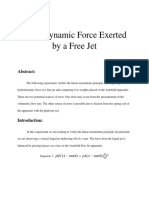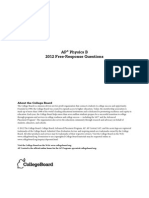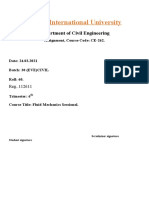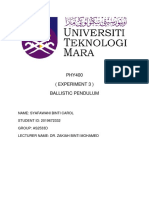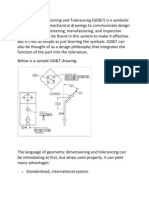MM222-Week 3 - Lab 4
MM222-Week 3 - Lab 4
Uploaded by
Mohammed Arif KhanCopyright:
Available Formats
MM222-Week 3 - Lab 4
MM222-Week 3 - Lab 4
Uploaded by
Mohammed Arif KhanOriginal Title
Copyright
Available Formats
Share this document
Did you find this document useful?
Is this content inappropriate?
Copyright:
Available Formats
MM222-Week 3 - Lab 4
MM222-Week 3 - Lab 4
Uploaded by
Mohammed Arif KhanCopyright:
Available Formats
MM 222 – Fluid Mechanics
The University of the South Pacific
School of Engineering and Physics
MM 222 – Fluid Mechanics
Lab 1: Hydrostatic Force
Lab Session Time: Wednesday 5- 8pm
Student Name: Mohammed Arif Khan, Tashif Hussein
Student ID#: S11157296,
AIM
To investigate the pressure acting on a submerged surface and to determine the position of the
Center of pressure.
INTRODUCTION
Water at rest (or relatively slow moving water) exerts a hydrostatic force (pressure) on the walls of dams, large
ducts, canals and against canal gates (in canal locks). This hydrostatic force is not the same as that fluid force at the
bottom of the dam or canal, as it is applied at a steeper angle (usually right angle) and changes with the height of
water (submersion of the plane). Engineers need to know how to predict this force to help understand the strength
and design of structures needed to resist it.
The design of these components necessitates the understanding of how fluid forces act. Such designs require not
only determination of the magnitude of the resultant force but also its point of action, which is known as the ‘’center
of pressure "(yp).With this information, engineers can design the hydraulic structure to withstand the hydrostatic
forces.
In this experiment, we will be using an immersed quadrant tank pivoted at a knife e-edge pivot to determine the
center of pressure of different values of hydrostatic force. This is achieved by computing the moment, M required to
counter the moment induced by the hydrostatic force due to water acting on the quadrant tank. The restoring
(counter-clockwise) moment needed to overcome the clockwise moment (about the pivot) caused by water is
effected by placing known weights on the left-hand end of the apparatus. In the experiment, if the clockwise
moment (induced by water) just balances the counter-clockwise moment (caused by the weights), the moment arm
and hence the center of pressure can be computed. The latter can then be compared with that calculated
theoretically.
EQUIPMENT
Hydraulic bench
Hydrostatic Pressure Apparatus
METHODOLOGY
1. The dimensions a, b and d of the quadrant was measured and the distance between the
Pivot and the weight hanger L.
2. The quadrant was inserted into the tank locating the balance arm on the knife edges. Adjust the
Counter-balance weight until the balance arm is horizontal, as indicated on the datum level
Indicator.
3. The tank was filled with water and later on masses was added to balance the balance arm.
4. More water was filled and masses was increased to balance the balance arm.
5. Same procedure was repeated and the results were recorded.
Lab Report Page 1
MM 222 – Fluid Mechanics
RESULTS
Table 1
Experimental Data
r q m yc Theoretical (mm) Experimental (mm) Force
(mm) (mm) (kg) (mm) yn yp yn yp N
101 99 0.22 50.5 166.33 67.33 158.47 59.47 3.75
107 93 0.245 53.5 164.33 71.33 157.24 64.24 4.20
112 88 0.260 56 162.67 74.67 152.30 64.30 4.61
115 85 0.270 57.5 161.67 76.67 150.02 65.02 4.86
SAMPLE CALCULATIONS
Using the constants:
P = 275 mm
b = 75 mm
d = 100 mm
ρwater = 998 kg/m3
Theoretical Values
r 2
yc= y p= r y n= y p + q
2 3
101 2
¿ = (101) =67.33+99
2 3
= 50.5 = 67.33 =166.33
Experimental Values
2 Pm
y n= y p= y n−q
ρb r 2
(2)(275)(0.22)
¿ = 158.47 - 99
(9.98 ×10¿ ¿−7)(75)(1012 )¿
= 158.47 = 59.47
DISCUSSION
In this experiment, the quadrant was immersed by adding water to the tank, the hydrostatic force applied to
the vertical surface of the quadrant was determined by considering the following:
The hydrostatic force at any point on the curved surfaces is normal to the surface and resolves
through the pivot point because it is located at the origin of the radii. Hydrostatic forces on the upper and
lower curved surfaces, therefore, have no net effect – no torque to affect the equilibrium of the assembly
because the forces pass through the pivot.
The forces on the sides of the quadrant are horizontal and cancel each other out (equal and opposite).
The hydrostatic force on the vertical submerged face is counteracted by the balance weight. The
resultant hydrostatic force on the face can, therefore, be calculated from the value of the balance weight and
the depth of the water.
Lab Report Page 2
MM 222 – Fluid Mechanics
The system is in equilibrium if the moments generated about the pivot points by the hydrostatic force
and added weight (=mg) are equal, i.e.:
Where:
m: mass on the weight hanger,
L: length of the balance arm
F: Hydrostatic force, and
y: distance between the pivot and the center of pressure
CONCLUSION
The hypothesis to consider moments created by hydrostatic forces on the curve faces is zero. Where the
center of pressure on an object will increase as the object is submerged more into the water; i.e. water depth
increases. The errors present in the experiment has caused a slight difference from the theoretical values
from the experiment values but the errors are not significant.
REFERENCE
B.R. Munson, D.F. Young, and T.H. Okiishi, Fundamentals of Fluid Mechanics, 4th ed., 2002, Wiley and Sons, New
York
Lab Report Page 3
You might also like
- A diamond -wedge airfoil with a half-angle ε = 10° is placed at an angle of attack α = 15° in a Mach 3 freestream. Calculate the lift and wave-drag coefficients for the airfoil. SolutionDocument3 pagesA diamond -wedge airfoil with a half-angle ε = 10° is placed at an angle of attack α = 15° in a Mach 3 freestream. Calculate the lift and wave-drag coefficients for the airfoil. SolutionVijay Kishore80% (5)
- ReportDocument6 pagesReportshagsNo ratings yet
- Fluids Mechanics Group ProjectDocument19 pagesFluids Mechanics Group Projectsaifadamzs100% (3)
- Asomah1997 PDFDocument9 pagesAsomah1997 PDFMd SerajuddinNo ratings yet
- Forced Vortex FlowDocument12 pagesForced Vortex FlowSaravin Selhvadurai100% (1)
- Ch10-Slope Stability ExamplesDocument19 pagesCh10-Slope Stability ExamplesRafi Sulaiman100% (3)
- Impact of Jet On VanesDocument5 pagesImpact of Jet On Vanesanil chejara100% (7)
- Fluids 2 Experiment 3Document8 pagesFluids 2 Experiment 3Bench CiudadanoNo ratings yet
- Experiment 1 Center of PressureDocument12 pagesExperiment 1 Center of PressureOsama RashaydaNo ratings yet
- Exp 2 Cooling TowerDocument15 pagesExp 2 Cooling TowerFong Cai YingNo ratings yet
- Lab Section - Impact On Jet PDFDocument12 pagesLab Section - Impact On Jet PDFYan TrindadeNo ratings yet
- Mech300 3 0Document92 pagesMech300 3 0pankarvi6No ratings yet
- Lab 4 Formal ReportDocument14 pagesLab 4 Formal ReportMohd Haikal ShukorNo ratings yet
- European University of Lefk Faculty of Engineering: Lab ReportDocument6 pagesEuropean University of Lefk Faculty of Engineering: Lab ReportShodi BekNo ratings yet
- Mechanical Vibrrations Lab Manual: Name Dua SaboorDocument5 pagesMechanical Vibrrations Lab Manual: Name Dua SaboorUmbreen TariqNo ratings yet
- Fluids Lab ReportDocument15 pagesFluids Lab ReportWillybumbum12No ratings yet
- Fluids Lab ReportDocument15 pagesFluids Lab ReportWillybumbum12No ratings yet
- Impact of JetDocument12 pagesImpact of JetShafizNo ratings yet
- Constantino Ethan Lab1Document17 pagesConstantino Ethan Lab1ulrichvonliepshtensteinNo ratings yet
- ManoMeter PCI Lab Report grp-5Document10 pagesManoMeter PCI Lab Report grp-5randomusermanas1No ratings yet
- Chapter 2 (Part 1) - Compressibility and ConsolidationDocument27 pagesChapter 2 (Part 1) - Compressibility and ConsolidationNoridah SamakonNo ratings yet
- Free Jet LabDocument7 pagesFree Jet Labaeroscribble0% (1)
- Solidification Part IDocument21 pagesSolidification Part Iเดี่ยว หมื่นลี้No ratings yet
- Fluid Mechanics Sessional CE 262Document28 pagesFluid Mechanics Sessional CE 262মোঃমেহেদী হাসান শরীফNo ratings yet
- Hydrustatic Force On Plane Submarged SurfacesDocument11 pagesHydrustatic Force On Plane Submarged Surfacesعبدالله عمرNo ratings yet
- Fluid Mech ModuleDocument66 pagesFluid Mech ModuleVudayagirisivaNo ratings yet
- Hydrolics Lab 1 PDFDocument14 pagesHydrolics Lab 1 PDFMahmoudRadiNo ratings yet
- Lab10 Group1Document7 pagesLab10 Group1afgchannel123No ratings yet
- Practical Report Submission Group 3_217152945_attempt_2021-06-30-17-04-39_Fluids Prac Report 2021Document12 pagesPractical Report Submission Group 3_217152945_attempt_2021-06-30-17-04-39_Fluids Prac Report 2021TshepoNo ratings yet
- Umar Lab ReportDocument24 pagesUmar Lab ReportMia HussainNo ratings yet
- Fluid Mechaics Lab Report Group 6Document18 pagesFluid Mechaics Lab Report Group 6Lestor NaribNo ratings yet
- The Critical Depth-Derivation of The Specific Energy EquationDocument21 pagesThe Critical Depth-Derivation of The Specific Energy Equationpotato9233% (3)
- FF Exp 2Document9 pagesFF Exp 22020ch58No ratings yet
- AP 2012 Physics B Free Response QuestionsDocument12 pagesAP 2012 Physics B Free Response QuestionsAlan G.No ratings yet
- MECH 2262 Lab 1Document10 pagesMECH 2262 Lab 1Anastasiya YermolenkoNo ratings yet
- Forced Convection Heat Transfer: Chemical and Biomolecular Engineering Lab / Bioengineering LabDocument17 pagesForced Convection Heat Transfer: Chemical and Biomolecular Engineering Lab / Bioengineering LabMichelle LiauNo ratings yet
- Centre of PressureDocument15 pagesCentre of PressureMAC DARREL MICHAEL MAC DARREL MICHAELNo ratings yet
- Practical Report Submission Group 4_217228607_attempt_2021-07!01!10!45!05_217228607 3fluids Mechanics Practical ReportDocument19 pagesPractical Report Submission Group 4_217228607_attempt_2021-07!01!10!45!05_217228607 3fluids Mechanics Practical ReportTshepoNo ratings yet
- Fluid Mechanics Sessional CE 262Document28 pagesFluid Mechanics Sessional CE 262মোঃমেহেদী হাসান শরীফNo ratings yet
- 01 - PDC Study of Step Response of First Order SystemDocument8 pages01 - PDC Study of Step Response of First Order SystemNeena Regi100% (1)
- FM Lab Exp1 Venturimeter B191194ceDocument10 pagesFM Lab Exp1 Venturimeter B191194ceIm walker707No ratings yet
- Experiment 4B HyDocument6 pagesExperiment 4B Hyakmal hazimNo ratings yet
- Mini Project (Report) (Aditya Gunin)Document20 pagesMini Project (Report) (Aditya Gunin)Soham SahaNo ratings yet
- Forced Convenction Lab Report 1. 1 Overview: Done by Ben Claude UWIHANGANYE, Reg. No: ENM311-2672/2016 JKUATDocument10 pagesForced Convenction Lab Report 1. 1 Overview: Done by Ben Claude UWIHANGANYE, Reg. No: ENM311-2672/2016 JKUATEugene100% (1)
- Fluid Jet Impact Hob FinalDocument13 pagesFluid Jet Impact Hob FinalIsrael ChishalaNo ratings yet
- SHM LabDocument4 pagesSHM LabbrieNo ratings yet
- Lab Report Exp 3: Impact of Jet: Fluids Mechanic (MDB 2013) Semester May 2019Document17 pagesLab Report Exp 3: Impact of Jet: Fluids Mechanic (MDB 2013) Semester May 2019Umar ShahNo ratings yet
- Fluid Mechanics Aug-Dec 2013: Professor Dr. Luis E. Lesser Carrillo Hydrogeologist/Environmental EngineenerDocument44 pagesFluid Mechanics Aug-Dec 2013: Professor Dr. Luis E. Lesser Carrillo Hydrogeologist/Environmental EngineenerarunyogaNo ratings yet
- Expt No 1 Band Gap of A SemiconductorDocument8 pagesExpt No 1 Band Gap of A SemiconductorNayan ChandakNo ratings yet
- Final Lab Report Flow MeasurementDocument7 pagesFinal Lab Report Flow Measurementtransteven93No ratings yet
- Experiment 3: Ballistic PendulumDocument11 pagesExperiment 3: Ballistic PendulumsyafNo ratings yet
- Report Edwards Copy May20Document10 pagesReport Edwards Copy May20Rishav KrishnaNo ratings yet
- Test Information: PHYSICS SECTION-1 InstructionDocument30 pagesTest Information: PHYSICS SECTION-1 Instructionipsita lahiriNo ratings yet
- Hysteretic Damping Modelling by Nonlinear Kelvin-Voigt ModelDocument6 pagesHysteretic Damping Modelling by Nonlinear Kelvin-Voigt ModelPaul Pinedo VilcahuamánNo ratings yet
- PresentationDocument13 pagesPresentationselva_raj215414100% (1)
- A. Determination of Metacentric Height For A Given Ship ModelDocument9 pagesA. Determination of Metacentric Height For A Given Ship ModelKoushik Ch 19BME1186No ratings yet
- Phys1012 T102 ZeroDocument17 pagesPhys1012 T102 ZeroYohana Christyn SinagaNo ratings yet
- Analytical Modeling of Solute Transport in Groundwater: Using Models to Understand the Effect of Natural Processes on Contaminant Fate and TransportFrom EverandAnalytical Modeling of Solute Transport in Groundwater: Using Models to Understand the Effect of Natural Processes on Contaminant Fate and TransportNo ratings yet
- HDD Collapse Case StudyDocument14 pagesHDD Collapse Case StudyVivek PandeyNo ratings yet
- List of Mathematical Symbols: Symbol Symbol Explanation ExamplesDocument16 pagesList of Mathematical Symbols: Symbol Symbol Explanation ExamplesKostas LaftsidisNo ratings yet
- Ch-9 Science PYQsDocument11 pagesCh-9 Science PYQsglusac261No ratings yet
- Table of Laplace and Z TransformsDocument4 pagesTable of Laplace and Z TransformsChristian BausoNo ratings yet
- Problem33 56Document1 pageProblem33 56IENCSNo ratings yet
- CH 3+4+5+6+7 PDFDocument149 pagesCH 3+4+5+6+7 PDFzuhair faddahNo ratings yet
- Fluid Mechanic 151 200 PDFDocument50 pagesFluid Mechanic 151 200 PDFHiteshNo ratings yet
- Exploring The Effectiveness of A Design-Thinking Instructional Module in STEM Context For Optimal Learning of Difficult Physics ConceptsDocument11 pagesExploring The Effectiveness of A Design-Thinking Instructional Module in STEM Context For Optimal Learning of Difficult Physics ConceptsInternational Journal of Innovative Science and Research TechnologyNo ratings yet
- BS en 1677-6 2001+a1 2008Document24 pagesBS en 1677-6 2001+a1 2008chx6sprrvcNo ratings yet
- Lecture 7 Forced and Damped Oscillations PDFDocument3 pagesLecture 7 Forced and Damped Oscillations PDFSahaj ChhetriNo ratings yet
- Counter BoreDocument11 pagesCounter BoreSURYA20051961No ratings yet
- Properties of Cable With Enhanced Single-Mode Fibre C40Document2 pagesProperties of Cable With Enhanced Single-Mode Fibre C40RazvaniQQQ77777No ratings yet
- Course Notes DES (TU Berlin)Document93 pagesCourse Notes DES (TU Berlin)IRONPUMANo ratings yet
- An Experimental Investigation of A Single Stage Wet Gas Centrifugal CompressorDocument11 pagesAn Experimental Investigation of A Single Stage Wet Gas Centrifugal CompressorAnibal AriasNo ratings yet
- An Study On Steel Fiber Reinforced ConcreteDocument26 pagesAn Study On Steel Fiber Reinforced ConcreteVìctòry Vèérá100% (1)
- Mechanical PropertiesDocument38 pagesMechanical PropertiesDave Harrison FloresNo ratings yet
- 1 Introduction To Microscopy 2024Document15 pages1 Introduction To Microscopy 2024Lindelwa MbeluNo ratings yet
- Instant Ebooks Textbook (Ebook PDF) Foundations of Astronomy 14th Edition by Michael A. Seeds Download All ChaptersDocument51 pagesInstant Ebooks Textbook (Ebook PDF) Foundations of Astronomy 14th Edition by Michael A. Seeds Download All Chaptersbrlekdjanel88100% (4)
- Lock in Amplifiers OverviewDocument37 pagesLock in Amplifiers OverviewMister DumbledoreNo ratings yet
- Application of System of Linear Equations 2018Document42 pagesApplication of System of Linear Equations 2018VuKhang NguyenNo ratings yet
- Achenbach 68Document15 pagesAchenbach 68emilienbruand0No ratings yet
- Acjc 9758 2023 Prelim p1Document9 pagesAcjc 9758 2023 Prelim p1Shen Yue Er (Rvhs)No ratings yet
- Balzer & Sneed-Generalized Net Structures of Empirical Theories IIDocument28 pagesBalzer & Sneed-Generalized Net Structures of Empirical Theories IIpablo lorenzanoNo ratings yet
- 2021 05 07 Projekt Dec o Oplatach 21 22 CUDZ - ENGDocument10 pages2021 05 07 Projekt Dec o Oplatach 21 22 CUDZ - ENGEmin yılmazNo ratings yet
- Science Form 1 Chapter 1.1set3Document3 pagesScience Form 1 Chapter 1.1set3Thevi MaruthiayahNo ratings yet
- Engineering Mathematics: D y 0 D y DX D y DX D y DXDocument2 pagesEngineering Mathematics: D y 0 D y DX D y DX D y DXJordan-James OlivoNo ratings yet
- Study of A Stick-Slip PhenomenonDocument16 pagesStudy of A Stick-Slip PhenomenonLaurent MagriNo ratings yet
- Weekly Test 07 _ Test Papers __ Arjuna JEE AIR 2.0 2024Document10 pagesWeekly Test 07 _ Test Papers __ Arjuna JEE AIR 2.0 2024Atharv ChauhanNo ratings yet
- (Elliot Leader, Enrico Predazzi) An Introduction T Vol1 (B-Ok - CC)Document543 pages(Elliot Leader, Enrico Predazzi) An Introduction T Vol1 (B-Ok - CC)francesco lombardiNo ratings yet





















